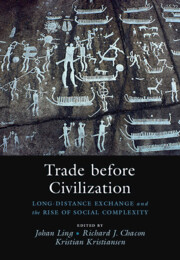Book contents
- Trade before Civilization
- Trade before Civilization
- Copyright page
- Contents
- Contributors
- Chapter One New Perspectives on Long-Distance Trade and Social Complexity
- Part I Exchange and Social Evolution: Forms of Trade in Egalitarian, Transegalitarian, and Chiefdom Societies
- Part II The Role That Specific Institutions And Agents Played in Long-Distance Exchange
- Part III The Role of Political Economy and Elite Control in Long-Distance Exchange
- Chapter Nine Lapita Long-Distance Interactions in the Western Pacific
- Chapter Ten Trade and the Hillfort Chiefdoms of Bronze Age Ireland
- Chapter Eleven The Turquoise Corridor
- Part IV Marxian And Post-Colonial Approaches as well as World System Theory in Relation to Gift Exchange and MacroRegional Exchange
- Part V Commentary on Contributions to This Volume
- Index
- References
Chapter Nine - Lapita Long-Distance Interactions in the Western Pacific
From Prestige Goods to Prestige Practices
from Part III - The Role of Political Economy and Elite Control in Long-Distance Exchange
Published online by Cambridge University Press: 25 August 2022
- Trade before Civilization
- Trade before Civilization
- Copyright page
- Contents
- Contributors
- Chapter One New Perspectives on Long-Distance Trade and Social Complexity
- Part I Exchange and Social Evolution: Forms of Trade in Egalitarian, Transegalitarian, and Chiefdom Societies
- Part II The Role That Specific Institutions And Agents Played in Long-Distance Exchange
- Part III The Role of Political Economy and Elite Control in Long-Distance Exchange
- Chapter Nine Lapita Long-Distance Interactions in the Western Pacific
- Chapter Ten Trade and the Hillfort Chiefdoms of Bronze Age Ireland
- Chapter Eleven The Turquoise Corridor
- Part IV Marxian And Post-Colonial Approaches as well as World System Theory in Relation to Gift Exchange and MacroRegional Exchange
- Part V Commentary on Contributions to This Volume
- Index
- References
Summary
This chapter will explore aspects of the Lapita culture of the Western Pacific, the culture of the initial colonizers of ‘Remote Oceania’, the area beyond the main Solomons chain around 3000 BP (Figure 9.1). The Lapita culture appears earliest in identifiable form in the Bismarck Archipelago off New Guinea a century or two earlier but derives in large part from the strand of the Island Southeast Asian Neolithic traceable to Taiwan around 5500 BP and beyond to southern China. There is evidence for Lapita long-distance interactions across some of the greatest distances found in Neolithic societies worldwide. The question must be posed, however, as to whether this represents exchange, particularly of prestige goods, or whether it signals some other form of interaction?
- Type
- Chapter
- Information
- Trade before CivilizationLong Distance Exchange and the Rise of Social Complexity, pp. 209 - 229Publisher: Cambridge University PressPrint publication year: 2022

